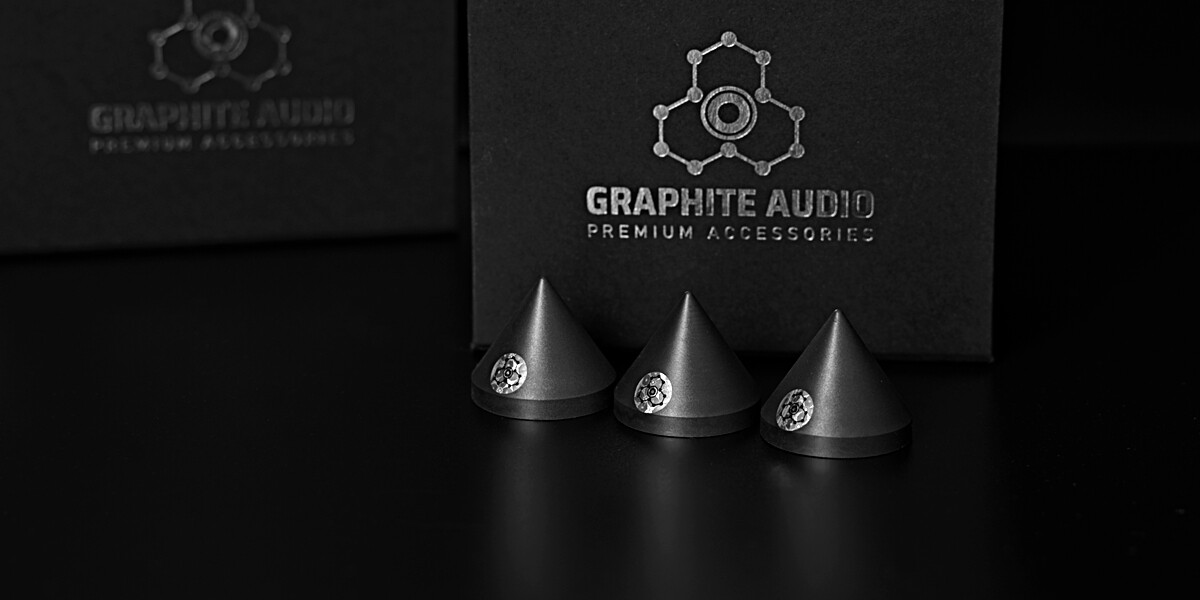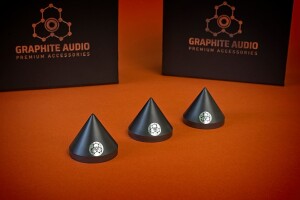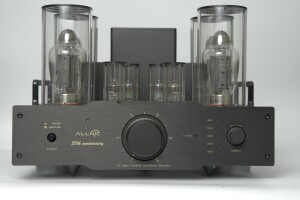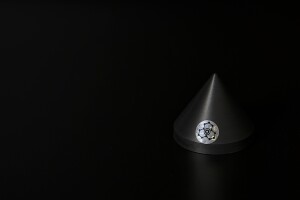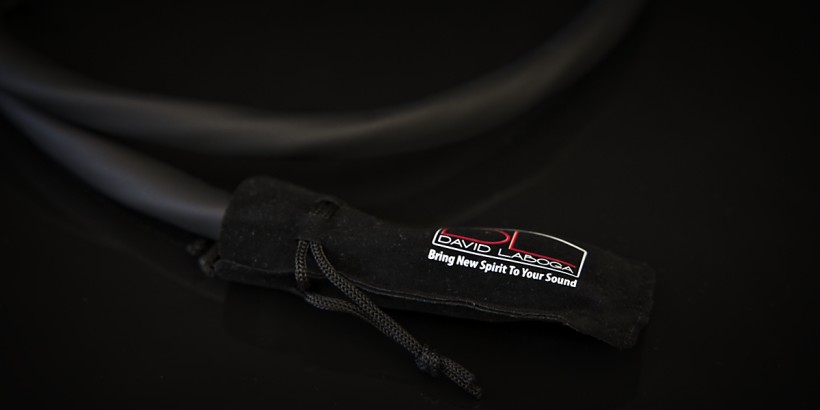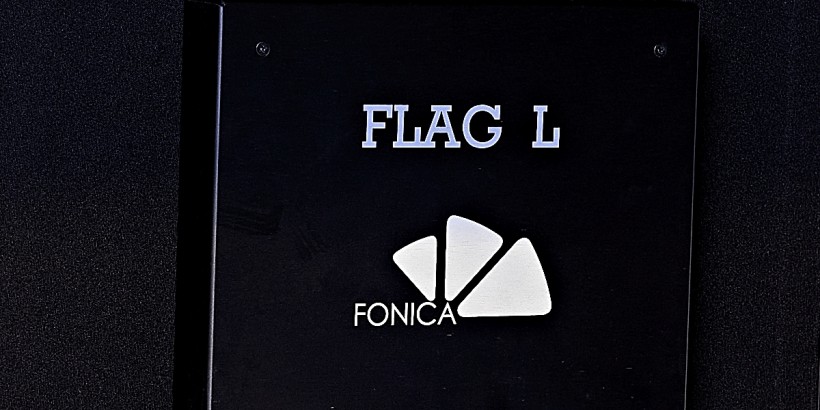Often, some time after painstaking process of building a „perfect” audio system is over, one begins to wonder whether its performance could get even better, ideally without investing another large amount of money and without changing its sonic character, that one has spent so much time refining. If you’re at this stage of your system’s development a new Polish brand may have an interesting offer for you – keep reading to find out more about Graphite Audio IC-35 isolation cones.
Introduction
The issue of vibrations being harmful to the performance of audio systems was once poorly understood and, probably for this reason, almost ignored. Until recently, products designed to counteract such harmful effects on the sound were called accessories, today they are just one of the audio products that sooner or later end up in most systems. Currently, the offer of anti-vibration feet, platforms, stands, racks and so on available on the market is huge and they are made of various materials, featuring numerous solutions, some of them truly exotic ones. On the one hand, this is a good situation for potential buyers – they can test and choose between as many products of various shapes and designs as they want. On the other hand, finding the ones that work best within a given budget in a given system is not easy, because hardly anyone has time to test dozens of such products.
Looking at it from the manufacturers’ point of view, such crowded market is not an ideal situation because of large competition, and it is even harder for those who only start their business. So in order to carve out a piece of cake for themselves, so to speak, they have to be able to stand out from the crowd, from the competition. being a music lover and audiophile, plus a reviewer myself I am in a unique position to get a first hand experience with many anti-vibration products. It so happens that there are several of them in our country and I had a pleasure to watch them grow over the years. That’s why I was excited to receive for a test new interesting propositions from a young Polish company, Graphite Audio. My goal is for you knowing, after reading this text, whether among hundreds of anti-vibration feet and cones you should make sure to try out what the Graphite Audio has to offer despite them being a newcomer to the market.
Let’s start from the beginning. One day a phone rang – an unknown number, but I picked it up. “Hello, this is Szymon Rutkowski. We know each other from Audio Shows – we usually met in Audio Mica rooms – a young guy, with glasses, rings any bells? In fact, I remember a youngster I met a few times in Audio Mica room, I thought to myself (despite the fact that at my age memory doesn’t work that well anymore). I have started my own business. I make anti-vibration products for audio systems. Maybe you would be interested in testing them? Are they good? – I asked – if so, of course I’m interested.” Soon after, I received two sets (three pieces in each) of IC-35 cones and two (four in each) of CIS-35 cable supports. As of today, the company, apart from the aforementioned products, offers one more, namely isolation speaker spikes bases, offered as the ISBS-40. We agreed Szymon would not send those, as any of my own speakers doesn’t feature spike, hence I wouldn’t be able to test them.
As I later learned from the manufacturer’s website, the research aimed at finding, above all, an appropriate material to make anti-vibration elements of, took quite a long time. According to Szymon, most of the materials used in this type of application – metal, ceramics, glass and so on – contribute their own sonic signature to the sound of the system, and that was not his goal. The idea of Graphite Audio from the very beginning was to offer products that would satisfy those who seek the most natural and most „high fidelity” presentation. While searching for the right materials our designer assessed numerous of the shelf as well as custom ones and it took him 2.5 years to find what he was looking for. What ultimately satisfied his expectations was a unique polymer but only a certain amount of graphite was added to it. Although it is not clearly stated anywhere, I assume that this is where the Graphite Audio’s name comes from.
All three of the above-mentioned anti-vibration products are made of the same material – apart from the information provided above, the manufacturer does not reveal any additional details. After all, there is no reason for him to make life easier for a competition. He only told me that processing this material is quite a challenge. From an up close experience, I can tell you that neither the IC-35 cones nor the CIS-35 cable supports look as strikingly as some of the others featuring shiny metal bodies. It’s just that it’s not, or at least it should be not, about having a nice looking gadget in an audio system, but rather a product that actually works, that eliminates vibrations, thus improving the sound. Since we don’t know any particular details of the tested cones the whole description can therefore be reduced to the statement that the Graphite Audio IC-35 are delivered in sets of three, packed in nice (obviously) graphite boxes filled with foam, in which appropriate cutouts were made. The foam protects the cones during transport, and the shape of the cutouts makes it easy to remove them. The cones are, say, gray-ish in color and they measure 30 (height) x 35 (diameter of the base) mm.
Sound
I’ve had the Graphite Audio IC-35 isolation cones at my disposal for quite a long time, which allowed me to check their impact on the performance of a number of my own, but also tested devices. The premise of testing this type of product is for it to replace the device’s own feet. It is possible provided that the latter are lower than the Graphite Audio’s product (which, as already stated, are not too high – they measure around 3 cm). Otherwise one has to remove original feet and use IC-35 instead. Fortunately, the former solution was feasible in most cases, and I had to use the latter only in the case of my reference DAC, LampizatOr Pacific. Its original feet are significantly higher so there was no way around removing them for the purpose of this test. In the first case, the tested feet should be placed as close to the original ones as possible – usually a particular location of the latter is not accidental – although experimenting is always advisable. When the original feet have to be remove one should try to place the tested ones exactly in the same spots, if possible. I tried to follow these rules during my assessment of the Graphite Audio IC-35.
The first device I paired the Graphite Audio cones with was my trusted Grandi Note Shinai integrated amplifier. It is a solid-state, Class A design weighing “just” 40 kg. The Italian amplifier features four metal feet, each of which ends in a semicircular shape. I once tried to ask Max Magri, the head and chief designer of the Grandi Note, why he decided to use such feet. I was curious because due to the shape and the material these feet are made of causes even such heavy amplifier to “slide” especially on smooth surfaces (such as the high-gloss finished shelves of my Base VI rack). Unfortunately, due to the language barrier – I don’t speak Italian, and Max doesn’t speak English quite enough to delve into technical solutions (or maybe he just didn’t want to reveal secrets?). In short, I have not been able to get an actual answer to this question.
Normally the amplifier is placed on a quartz Acoustic Revive platform, and this one rests on the bottom shelf of the aforementioned Base VI rack. For the purpose of this test, I placed three IC-35s between the amplifier and the platform not without difficulty (let me remind you once again, we are talking about a 40 kg sliding on the surface of the platform!) – two at the front and one in the back. I planned to use a second set under the source component, and since I had two sets of 3 pieces available I could use only 3 cones, not 4 for the amp. The cones were placed under the devices with their tips down (at least the amplifier stopped sliding :)). Before I did that, however, I consulted Szymon about the maximum load capacity of his cones. They are quite small, the material does not seem to be very hard, so there was a concern that they could deform or even crush under such weight. As I found out, three cones can easily hold a weight of up to 50 kg. Szymon told me that with a particularly big load it may happen that the sharp tips of these cones may get flattened a bit, but this is not a problem because it does not affect the anti-vibration properties of the IC-35 in any way.
What were the effects of using the Polish cones under Shinai? I would like to emphasize once again that this is a heavy device (and a large mass is one of the means of vibration damping in itself) and, in addition, it was already double damped, so to speak, as it was placed on a rack and, additionally, on an anti-vibration platform. This is probably why the influence of Graphite Audio was noticeable, but not significant. I perceived the changes as cosmetic (albeit positive) rather than revolutionary. I would even say that this first part of the test merely suggested what I could expect from the IC-35s, but it did not show it as clearly as the next listening sessions did. On the other hand, when after testing them with other devices, slightly more susceptible to vibrations, and thus also to the influence of Graphite Audio accessories, I already knew what to expect of them and decided to (over)strain my poor spine again to re-listen to the cones with my integrated, the changes seemed more distinct to me, even if still not revolutionary, not of the “I can’t live without them” genre.
To the point. Well, the Shinai is a fantastic amplifier – it sounds extremely natural, on the one hand quite tube-like in the best sense of the word (dense, colorful midrange, open, clean, strong, but also delicate treble), on the other hand, firm solid-state features are also there in terms of sound control and a solid, well-defined bass foundation. The impact of the IC-35 cones on the first try, in my opinion, focused on some improvement of the sound definition, especially in the bass range. The bass Shinai delivers is not that contoured as by many other solid-state counterparts, and the tested cones changed / improved this aspect a bit. And that’s about it. Everything was in the right place, so to speak, but a little „more”. Importantly, however, there were no negative effects of using the Graphite Audio cones. Often in such cases, we get some and lose some – there is an improvement in some respects, but other ones seem to lose a bit, and the decision to keep such a product in the system is based on pros and cons balance. In this case, however, the influence was not large, but there were no disadvantages. I took it as a good sign for further experiments.
One of the devices that I tested at the same time was a new tube amplifier from the Warsaw-based company Audio Reveal, namely their latest and entry level integrated, appropriately named Junior. Despite the lower price and smaller size, it is still a dual mono design with a single ended output, this time using a pair of 6550. Tube devices are by definition more susceptible to the harmful effects of vibrations than solid-state ones, so the use of the IC-35 in this case seemed justified, despite the fact that the factory feet on Junior seemed to be doing quite a good job. So Junior was placed on (this time) four cones, on top of the same quartz platform, but in this case the latter rested on the top shelf of the Base VI rack. Each of the cones was placed as close to the original foot as possible. It took only a few minutes of listening (I did not turn the amplifier off while installing the cones, so a warm up period was not necessary) to clearly hear their impact. The point is not that this time the changes were revolutionary – if they were to occur after using any anti-vibration accessories, it would have to mean that the product (amplifier / source) was a really mechanically badly constructed device, which was definitely not the case. It was rather about tangible gains significant enough to seriously consider pairing the cones with Junior for good.
The changes followed the direction Shinai had indicated earlier, but were clearer, easier to pinpoint. The sound presented by Junior placed on the IC-35 gained in terms of definition, focus, and going further clarity, as well as detail, or maybe rather resolution. The latter improvement resulted from the aforementioned ones – a more orderly, or better internally organized and clearer sound which translated into a better, more effortless insight into those smallest information, details and subtleties. To be clear, all that tiny information must be there – neither the IC-35, nor any other similar products is able to add anything from themselves. They only may make it easier for a listener to benefit from the information that a given system already replays from a recording, but which, without the tested cones, may disappear in the background noise. The Graphite Audio IC-35 fulfilled this task, frankly speaking, surprisingly well. My surprise did not result from the lack of faith in the abilities of their designer, but rather from the fact that his products are inconspicuous, they are also not particularly expensive, and in my system they were just another, actually third anti-vibration protection layer that added on top of contribution of the rack and platform. I’ve been using the latter two elements for several years already and they had been selected because they proved to do a pretty good job. And yet, the IC-35 set was able to further improve the sound.
At some point during the test, while still listening to Junior, instead of the reference Pacific DAC, I decided to use another fabulously musical and highly addictive while relatively inexpensive D/A Converter from Switzerland, namely the Merason Frérot (you can find my review in the September issue of the Audio Video magazine). This baby-DAC (weighs less than one kilogram) costs about 5,000 PLN and I really liked its sounds – as a side note let me highly recommend listening to it if you’re on the market for not too expensive, but extremely musical D/A Converter. I simply felt that the Merason would be a great partner for the Junior (especially when supported additionally with an optional, proprietary external POW1 power supply) and as it turned out, I was right. These two devices, both, at least considering the current „climate” on the audio market, are relatively inexpensive and combined they delivered beautiful musical performances for me. The Swiss DAC features its own micro-feet, so I quickly came up with the idea of placing three Graphite Audio IC-35 cones under it. It turned out to be quite a challenge, because raising the whole, so light, DAC by 3 cm introduced an unbalance, meaning that the connected cables (not particularly thick or heavy ones at all) began to pull the whole device back, but I managed to get the situation under control. I was worth it, because when both, the amplifier and the converter, were placed on the IC-35s, their influence on the sound accumulated.
Apart from the even pronounced qualities already described, introduced by the tested cones to the sound, now I heard another one, which I was not entirely sure before was real. Namely, using the Graphite Audio under both, the source and the amplifier, had a positive effect on … the intensity of the timbre of instruments and vocals. The effect was similar to that of moving a proper slider in some graphic software, or in TV set’s controls, increasing colors intensity. To be clear – increasing them in a sensible way, without a hint of exaggeration. The positive change was significant enough, though, so that removing the cones from under just one of these devices, caused the sound to become more “grey”, less interesting, not so pleasant, so enjoyable anymore. Graphite Audio’s cones are not a cheap product, but also they do not cost so much that could not be considered a reasonable upgrade even for a 5000 PLN DAC, not to mention a 15 kPLN amplifier. In my opinion current and future Frérot and Junior owners should give the Graphite Audio IC-35 isolation cones a try.
One of the next devices, I tried the IC-35 with, was another tube integrated amplifier, this time from a significantly higher price level. To be exact it was a three times more expensive (than the Junior) Allnic Audio T-2000 30th Anniversary. It features two KT170 tubes per channel in the output stage hence offering up to 120 W output per channel (in pentode mode and half of that in triode one). Let me also point out that the Korean device is in the same weight category as the Shinai. It directly replaced Junior in the system (i.e. was placed on the platform located on the rack’s top shelf). It come with four own feet made of some kind of quite hard, but still rubber. It is a remarkable device – you will be able to find more details about it in my upcoming review for the “HighFidelity” magazine, but the Polish cones were again able to bring out even more quality from it.
The difference (its scale) was slightly smaller than that of the Junior case, but still significant. What I heard was more compact bass, better internal order of the whole presentation, the impression of a slightly higher clarity of the sound coming from the speakers, and at the same time its greater saturation. All of these features together contributed to a sufficient, even if not dramatic, improvement in the amp’s performance, surely (in my opinion) sufficient to add another 2000 PLN for a set of the IC-35 on top of the 45,000 PLN this integrated will set back each owner. Especially after you try these cones out because while the difference cause by adding them to the mix may not seem so significant, listening to the amp without them later turns out quite a painful experience. You will quickly realize that you’re missing something and that it is hard to accept once you first taste the even better performance achieved with the Graphic Audio IC-35.
Finally, despite the reluctance resulting from my innate laziness, I started a slightly more complicated operation involving removing Pacific’s feet and replacing them with the Graphite Audio IC-35. After that I started listening with the Allnic Audio T-2000 30th Anniversary still in a system, also placed on the tested cones. For this feet replacement operation I turned the Pacific off for a few minutes, so after turning it back on it needed several minutes before reaching its optimal performance level. Before I turned it off I simply paused playback in Roon while playing one of the tracks from the “Thunder” by the S.M.V (Stanley Clarke, Marcus Miller, Victor Wooten), and righter after turning the DAC back on, I immediately pressed “play”. And? I assumed that to hear the impact of the IC-35 on the sound I would have to wait a dozen or so minutes for the Pacific warm up again. Yet, from the very first minute, the influence was most audible among all the devices tested with the Graphite Audio cones. The nature of the changes was similar – I got a more focused, better organized sound, better “access” to the smallest details and subtleties, but without the presentation becoming overly analytical, there was better saturation of the sound, and yet it didn’t get warm and greater clarity didn’t result in brightening of the sound.
Let me emphasize once more, that I am talking about changes introduced by the IC-35 that one could try to quantify as no more than a few percent, but in this case it was, say, 3-4%, not 2% as with other components placed on the reviewed cones. With LampizatOr, although I have never had any objections to this aspect of its performance, this better internal organization of the presentation also concerned space, both the acoustics of recordings and drawing individual large, tangible phantom images using a slightly sharper line, so to speak. The IC-35 used simultaneously under the Allnic Audio and Pacific had additional benefit of the loudspeakers disappearing from the room in an even more convincing way. This applied to virtually every recording, including out-of-phase sounds, used, for example, on Pink Floyd or Waters albums, coming not only from the sides of the room, but also from behind my head. My point is not that those spacial effects weren’t there without Graphite Audio cones, but only that with them the presentation seemed even more natural, convincing, precise and effortless.
Before summary let me offer current and potential users of the Graphite Audio IC-35 a piece of practical advice. These are small and light cones so placing them, tip down, under some heavy devices may be quite a challenge if you have to do it alone. Being aware that the manufacturer and some readers may strongly oppose this idea, I shall still suggest (in such cases) using a tiny little bit of BluTak. It is a white elastic mass often used, for example, between speakers and stands, so that the latter do not scratch the surface of the former, or to prevent the risk of the speaker moving or even falling off the stand. The two main features of the BluTak are considerable plasticity and the fact that it can be easily and completely removed from the surface it is applied to without leaving any traces on it. So if you have to use a tiny little piece, place it in the middle of the cones base and it will easily stick to the surface of the device. You will be still able to move (slide) it to correct positioning of the cone, but it will stay in place while you install other cones. Theoretically, it could have an impact on the cone’s properties – after all, it means putting „alien” material between Graphite Audio product and a component that is placed on it. My experience however did not shown any such an impact, but I can’t not say that it does not exist. Even if it does, it is minimal, perhaps beyond perception. That is why I suggest using the absolute minimum amount of the BluTak and only when it actually makes your life significantly easier.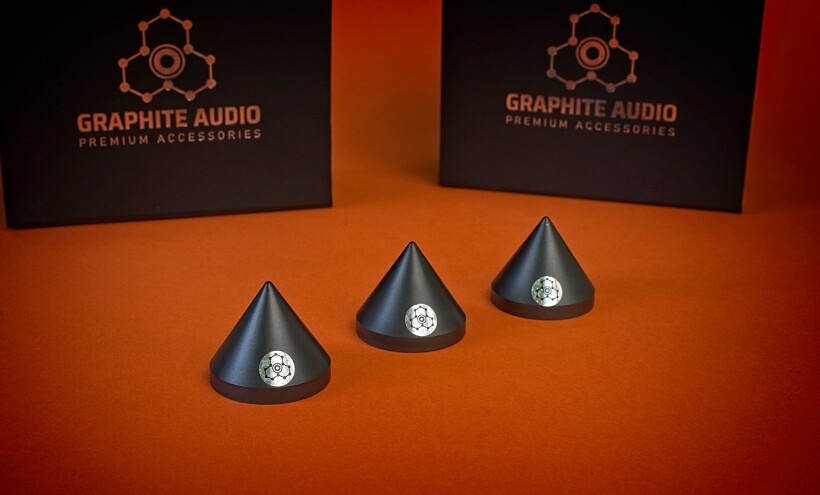
Summary
I had a chance to assess the influence of the Graphite Audio IC-35 on performance of several devices, in fact even more of them than were mentioned in the text. Based on all these experiences, I must say that if we were to rank products with an outstanding ratio of inconspicuous look versus the impact they have on the sound, the tested cones would easily take the first place and they would probably not give it up for a long time, maybe never. It is hard to believe looking at these small, gray, inconspicuous cones, that they can so clearly affect the sound of the components placed on top of them. Interestingly and importantly, one can expect a similar effect in terms a character that will only vary in scale depending on the device. It didn’t matter whether it was a source component or an amplifier, whether it featured tubes or transistors, the Graphite Audio IC-35 did their „magic” every time.
What surprised me even more was the fact, that I heard the influence of the tested cones most clearly with the most pricey device in the bunch, namely with the tube LampizatOr Pacific DAC. The smallest changes I heard when the IC-35 were used with the solid-state Grandi Note Shinai integrated, but even then, these were clear enough to seriously consider pairing the “Italian” amp with the cones for good. Even when it came to the 5 kPLN Merason Frérot, being its owner, I would seriously consider investing in such an upgrade. Importantly, in each case my impression was (because it is difficult to determine objectively) that thanks to Graphite Audio IC-35 cones a given component got a chance to present more of its capabilities, of its quality. What more can you expect from any anti-vibration “accessories”? To be clear – I do not suggest that you trust me completely and go and just buy a set or two of the IC-35 for your system. Yet, if you are looking for a relatively inexpensive upgrade, if you believe that your system still has some more quality in it that needs to be uncovered and you want to give it a chance to fully spread its wings, you should definitely get in touch with the manufacturer or one of his distributors/dealers and borrow a set (or more) for your own test in your own system. I am pretty sure they will prove to be worth of your time!
Price (when reviewed):
- Graphite Audio IC-35 isolation cones: 439 EUR / set of 3
Manufacturer: GRAPHITE AUDIO
Associated equipment:
- Digital source: a passive, custom server with WIN10, Roon, Fidelizer Pro 7.10, JCAT NET XE and JCAT USB XE cards with FERRUM HYPSOS power supply, KECES P8 (mono) linear power supply for the server, JCAT USB Isolator
- D/A Converter: LampizatOr Pacific +Ideon Audio 3R Master Time (USB signal regenerator)
- Analogue front end: J.Sikora Standard MAX turntable, J.Sikora KV12 tonearm, AirTight PC-3, phonostages: Grandinote Celio mk IV, ESE Lab Nibiru V 5.
- Power amplifiers: GrandiNote Shinai, Allnic Audio T-2000 30th Anniversary, Audio Reveal Junior
- Preamplifier: Audia Flight FLS1
- Loudspeakers: GrandiNote MACH4, Ubiq Audio Model ONE Duelund Edition.
- Interconnects: Hijiri Million, Hijiri HCI-20, TelluriumQ Ultra Black, KBL Sound Zodiac XLR, David Laboga Expression Emerald USB, David Laboga Digital Sound Wave Sapphire Ethernet
- Speaker cables: LessLoss Anchorwave
- Power cables: LessLoss DFPC Signature, Gigawatt LC-3
- Power: Gigawatt PF-2 MK2 and Gigawatt PC-3 SE Evo+; a custom power line with Gigawatt LC-Y in-wall cable; Gigawatt G-044 Schuko and Furutech FT-SWS-D (R)
- Racks: Base VI, Rogoz Audio 3RP3/BBS
- Anti-vibration accessories: ROGOZ-AUDIO SMO40 and CPPB16 platforms and ROGOZ AUDIO BW40MKII feet, Franc Accessories Ceramic Disc Slim Feet and Wood Block Platform


